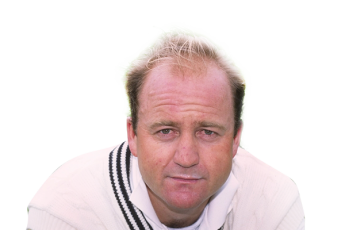Test Match Therapy: The Greatest Escapes 3
0Australia at Perth, November 24-28, 1989
Australia 521/9
NZ 231 & 322/7
Match Drawn
Those of us who lived through the 1992 World Cup will never forget it.
It was when New Zealand cricket unexpectedly burst out of dim decline and out into a new world of sunshine, coloured clothing, and packed houses. Led by a Superhero captain and infused with a sudden dashing self-belief, they knocked over nation after nation in a month of cricket which captivated the country.
Sometimes I still have difficulty believing it actually happened. Martin Crowe’s booming bat and John McEnroe headband; Mark Greatbatch smacking the world’s best bowlers into the stands; Dipak Patel opening the bowling; Kenny Rutherford making runs; people like Rod Latham suddenly taking on rock star status; Chris Harris with hair. It all seemed so surreal. It was almost as if Charles Manson’s house had suddenly arrived in town.
I went to game three, against South Africa at Eden Park. The news was initially grim when it was announced that Mr Reliable, John Wright, was out injured and would be replaced as opener by Mark Greatbatch. Mark Greatbatch opening? Whose idea was that? Turns out it was the same person who suggested Dipak Patel should open the bowling – Charles Manson.
Greatbatch went ballistic, scoring 68 off 60 balls in an era when One Day openers still established and then built an innings. He retained the role for the rest of the tournament and reached an improbable zenith in another game at Eden Park, against the West Indies. This time it was 63 off 77, and featured something I had never seen before: Coming down the wicket to both Malcolm Marshall and Curtly Ambrose and dispatching them into the Eden Park stands for six. And judging by the look on the faces of both Marshall and Ambrose – it was also something they had never seen before.
We all knew Paddy Greatbatch could produce dynamic cricket. For a big man he was surprisingly athletic in the field and was an aggressive batsman for Central Districts; where he and his Auckland Grammar mate Martin Crowe cut a nationwide pillage through first-class bowling attacks like two ruthless pirates. But he also possessed a stubborn ability to remain at the crease that at times bordered on the fanatical. And it was this stoic belligerence that marked out most of his international career and made his 1992 World Cup re-boot even more fascinating.
He was always someone who seemed destined to play for his country. And when he finally got the chance, against England in a Test match at Auckland in February 1988, he was determined to squeeze every last drop out of the experience. Making 11 in just over an hour in the first innings was an appetiser for what was to come second time round: A marathon seven-hour 107 not out off 328 balls. He became just the fourth New Zealander to score a Test Century on debut. And the first to leave everybody moribund in the process.
It was stupefyingly dull. I even wondered whether Greatbatch himself had also drifted off to sleep at some point. But it was also very effective in the circumstances. And that is what counted most at the end of a very trying day for all concerned.
And so fast-forward to Perth 18 months later. New Zealand had a one-off Test in Australia with a similar one to follow at the Basin Reserve in the new year. The pugnacious David Boon started things off in Perth by slowly cooking New Zealand in the desert sun as he compiled a double hundred and helped the home side reach 521. Mark Greatbatch then made a valiant 76 as New Zealand replied with 231. Forced to follow-on and 290 in arrears, Greatbatch quickly found himself back out in the middle with New Zealand at 11 for 2.
How can anybody confronted by such a scoreboard possibly be expected to mentally chart a successful escape? But Mark Greatbatch decided he would just bat. And bat. And bat. And he did. For 11 hours and 485 balls.
Saving a Test match requires more than one person, however, and Greatbatch received great support from firstly Jeff Crowe, then a 19-year old Chris Cairns playing his first Test, and most memorably by Martin Snedden, who batted almost four hours for his 33 runs.
Greatbatch eventually walked off undefeated on 146, salvage job successfully completed. It sits inside the 50 longest innings ever played in Test cricket, but in second place for a player scoring less than 150. It was a truly remarkable display of fortitude; and from a man who also had the audacity to once charge the great Malcolm Marshall and hit him over extra cover for six.
A young cricketer from New South Wales named Steve Waugh stood in the Perth sun for three days and watched Greatbatch bat and bat against a wilting home attack. One of the great thinkers of the game, Waugh would eventually lead Australia and change Test cricket by progressing the game at a much faster rate. He was also the first modern captain to consistently choose batting again over enforcing the follow-on. Some could therefore argue that Mark Greatbatch played a part in changing Test cricket forever.
More could successfully argue that Greatbatch did change One Day cricket. His blistering approach to opening when the field was up at the 1992 World Cup was successfully adopted shortly after by the Sri Lankan opening pair of Sanath Jayasuria and Romesh Kaluwitharana, and just about everybody since. It was also the type of batting that we all now take for granted in the T20 version of the game.
All in all, quite a legacy for anybody to leave.
Follow Euan on Twitter

